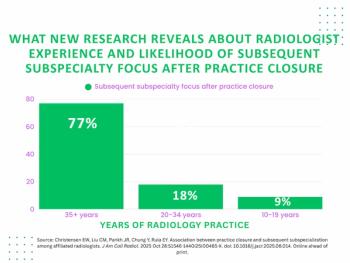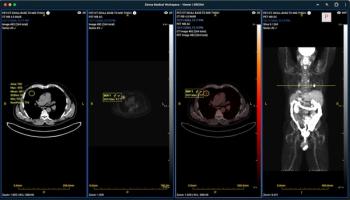
5 Indicators to Consider for Radiology’s Post-Pandemic Future
What department and practices leaders should focus on to be most successful post-COVID
The crystal ball is still cloudy surrounding radiology’s post-pandemic future, industry leaders said, but there are some areas where the need – and direction – for adaption is clear.
As the rollercoaster-shaped graph of COVID-19 cases recorded nationwide indicates, the experience of many providers in the industry will likely have two faces, said Geraldine McGinty, M.D., MBA, past chair of the American College of Radiology (ACR) Board of Chancellors and associate professor of radiology at Weill Cornell Medicine, and her Weill Cornell colleague Robert J. Min, M.D., MBA, professor and chair of radiology.
“Across our global radiology community, it is clear that our story will now divide into two chapters: pre- and post-pandemic,” they wrote in an opinion article published this week in the
In answer to that question, they offered insights and predictions in five key areas: reimbursement, regulations, replacement, research and education changes, and cyber attacks. Academic departments and independent practices alike should focus on each of these factors to have a more successful future.
Related Content:
“We believe that they need to plan for continued uncertainty combined with authentic transparent leadership is universally applicable,” they said.
Reimbursement
Universally, imaging volumes have dropped for radiology practices, and many will struggle to effectively recover their lost revenue. Many providers have already faced furloughs, reduced salaries, unpaid vacation, and consolidations as methods used to tread water. And, more changes are possible, McGinty and Min said.
Practices and departments should approach discussions of these changes directly, but with care. Handling them with a cavalier attitude can potentially lead to more problems.
“Effective leaders will communicate these changes transparently and with empathy as they evolve, applying similar or even greater cuts to their own compensation,” they explained. “How practices handle these decisions and their execution will be remembered in our relatively small professional community.”
Regulations
At the beginning of the pandemic, a plethora of government regulations and insurance changes not only made it easier for radiologists to render services in the most affected areas, but also cut the red tape to make it easier for patients to take advantage of imaging.
McGinty and Min made several predictions about how these regulatory change might survive the pandemic:
- Broader telehealth will continue, and relaxed state licensure will remain.
- Professional organizations will push for extended autonomous practice for advanced practice providers.
- Downward pressure will surface on fee-for-service rates.
- Employers will opt for less generous – or no – health insurance plans.
- More consolidation efforts are possible as more administrative barriers associated with state licensure are removed.
To ensure a successful reimbursement and regulatory future, academic departments and private practices must get involved in leadership organizations, they said. Being active members in the ACR, state radiology organizations, professional societies, and the Association of American Medical Colleges (for academic departments) can be a critical survival strategy.
Replacement
If nothing else, McGinty and Min said, the pandemic shone a spotlight on the vital role that radiologists play in patient care on a routine basis. Radiologists are no longer the faceless providers who read images in dark reading rooms far away from clinical exam rooms. Instead, they stepped in to provide care for COVID-19-positive patients in a variety of ways.
“Not only did they become part of the clinical teams in the intensive care units,” they said, “but, they uniquely added their imaging expertise, offering image viewing as part of rounds and performing bedside ultrasound-guided procedures.”
Even the rush to incorporate more artificial intelligence (AI) tools into the management and treatment efforts during the outbreak bolstered the importance and utility of having a radiologist in the room to pay eyes on a scan and provide experiences analysis. Instead of being a viable substitute for the provider, AI will remain a beneficial support tool.
“Imaging interpretation will, we predict, continue to be supervised by radiologists but for successful practices will incorporate mid-level providers and machine learning tools to augment the productivity of the radiologist,” they explained.
Research and Education Changes
While radiologist investigators have found ways to continue their research efforts via remote strategies, it has been harder to maintain professional educational opportunities, they said. Canceling professional conferences or switching to online platforms eliminated the possibility for providers to learn from each other and share ideas in person – and there’s no clear indicators for when those chances will return.
“Radiologists’ future willingness to travel to hear each other present research or deliver continuing education may be limited both by their own caution as well as that of their employer,” they said. “The loss of the informal networking associated with in-person meetings will undoubtedly have an impact but might also necessitate more structured processes for inclusion on committees and projects, which may benefit a more diverse group.”
The disruption into radiology research has had specific impacts, though. According to emerging data, the careers of women in radiology have been disproportionately impacted by the pandemic. In many cases, the constant juggling of family and work responsibilities has been complex. But, some academic institutions have reset the tenure clock by a year as an active measure to help female radiologists recover from this slowdown in productivity.
Cyber Attacks
With the inevitability of a second COVID-19 wave, departments and practices must be proactive in securing their home working capabilities. Up-to-date workstations and secure VPNs are critical parts of a safe workflow for providers and patients.
“Future departmental planning will need to account for the potential need to continue significant homeworking and to double-down on redundancy and data security,” McGinty and Min advised.
Ultimately, they said, this stage of the pandemic is not the time for radiology leaders to turn insular and focus only their own institutions. Finding the best way forward for the industry will require input from all corners of the profession.
“A willingness for leaders to acknowledge and take responsibility for decisions and to actively solicit a diversity of opinions to inform those decisions will improve organizational performance for the long term, as well as in crisis situation,” they said. “Great leaders will use this opportunity to share experiences, learn from others, and prepare the next general of health care executives.”
Newsletter
Stay at the forefront of radiology with the Diagnostic Imaging newsletter, delivering the latest news, clinical insights, and imaging advancements for today’s radiologists.






























